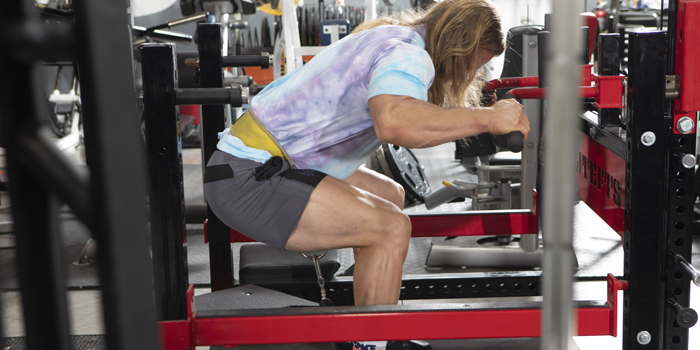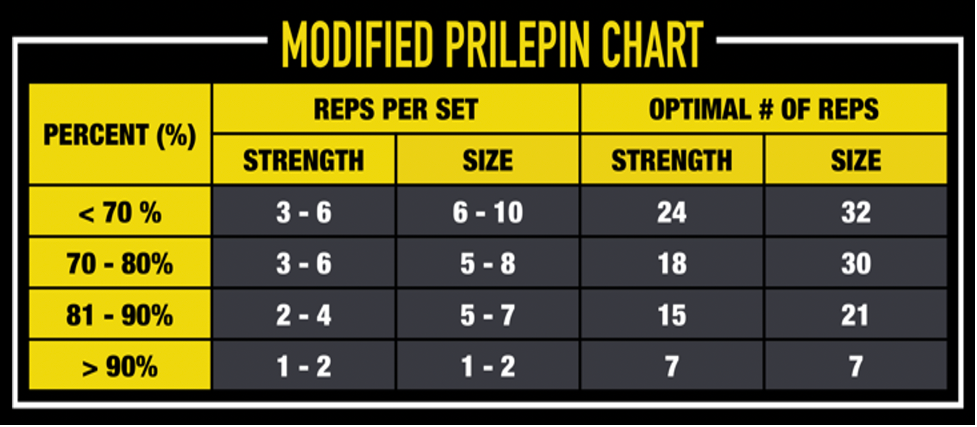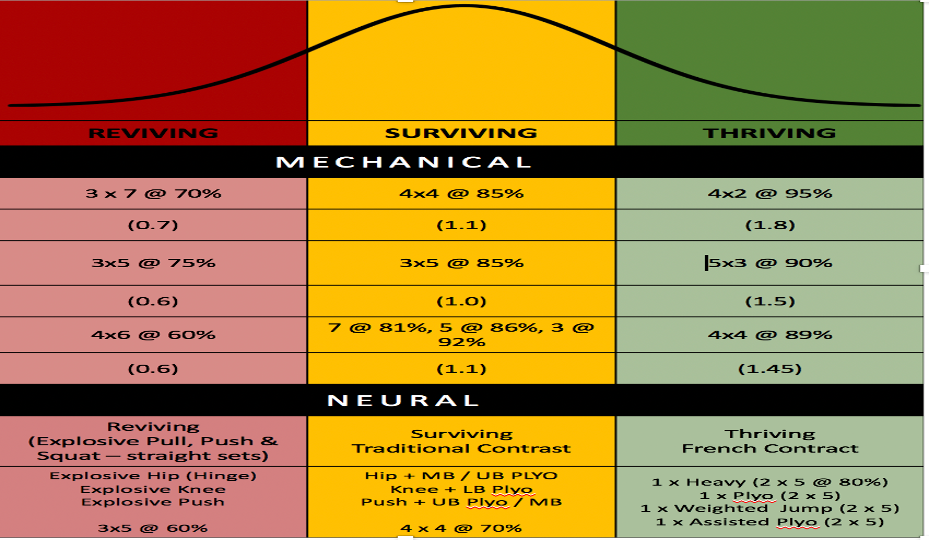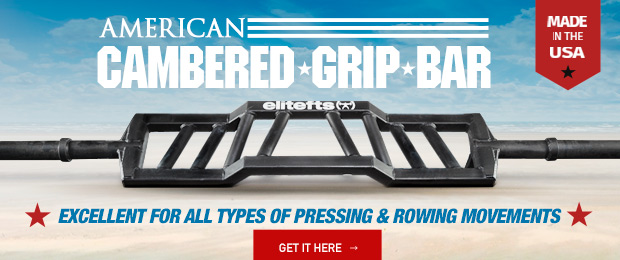
"The ability to train is governed by the ability to recover."
I don't remember where I first heard that phrase, but it rings true across all types of training. When I discovered the Intensity Number of Lifts (INOL) method of assessing training, I loved the numerical simplicity and the ease of classifying a session.
RECENT: In-Season Rugby Programming Utilizing the Westside Conjugate Methods
I also like using the bell-shaped curve when considering where a player fits into a type of training session. Since 68% of a population group falls between one standard deviation above and below the mean, I refer to this as the SURVIVING group. This leaves approximately 16% of the playing group below and above this grouping. The below group, which is the under-recovered group, is referred to as the REVIVING group, whilst the fully recovered and ready to give 100% effort are called the THRIVING group.
Of course, all curves can be skewed to the left or the right. More players will be in the other groups, but hopefully, more players will fall into the thriving group than any other with attention to detail.
A former player once told me that he was never 100% going into each game after his first year of professional rugby. So, we as coaches need to continually search for the optimal loading for each player and be aware of recovery times and scheduling of other training. A good starting point is Prilepin's Table, used in conjunction with the Intensity Number of Lifts (INOL) developed by Hritsove.
You can read the entire article here.
The table below outlines how the INOL can be used to assess the workout you have planned. Then you can manipulate to a percentage of 1RM and the sets and reps to allow you to work in a specific zone.

By using the INOL in combination with Prilepin's Table, you can design specific workouts based on a player's recovery status. To calculate the INOL use the following formula:
INOL = Number of reps/100 - % of 1RM
For example:
4 x 6 @ 75%
= 24/100 – 75
= 24/25
= 0.96
| <0.4 | Too few reps, not enough stimulus? |
| 0.4-1.0 | Fresh, quite doable and optimal if not accumulating fatigue |
| 1.0-2.0 | Tough, but good for loading phases |
| >2.0 | Brutal |
In the book Science and Practice of Strength Training, the authors detail recovery time between workouts of differing training loads. It's very useful in determining the volume and intensity of sessions and the number of such sessions that can be programmed into a weekly plan for optimal performance improvements. It is also specific to the work of Louie Simmons when determining the positioning of Maximal Effort and Dynamic Effort training sessions in the course of the training week. In the Westside Barbell system, the Dynamic Effort day is positioned 72 hours after the Maximal Effort day for the same region of the body.
| Zones | Training Load of One Workout | Restoration Time in Hours |
| 1 | Extreme | 72 |
| 2 | Large | 48-72 |
| 3 | Substantial | 24-48 |
| 4 | Medium | 12-24 |
| 5 | Small | <12 |
Below is the simple pen and paper test that I have used with a team to ascertain where each player is. I then follow up with a discussion to ensure we program effectively and educate players around specific recovery options that may be of better value to them in preparing for training.
Player Self Appraisal Information
A. Name:
B. The next game is against:
C. What aspect of my development do I want to focus on this week? Please be Specific.
D. Rate how physically fresh you are feeling now: Injured/Fatigued Sore/Tired/OK/Good/Awesome
E. Rate how mentally fresh and focused you are feeling now: Not Focused or Fresh Mentally/Tired/OK/Fresh & Focused
F. Rate your Recovery from the previous game and explain what you did:
1 2 3 4 5 6 7 8 9 10
Not Recovered/Fully Recovered
G. Rate how physically ready you are to meet the challenge of this week's game:
Sore/Fatigued Sore/Tired/OK/Good/Primed & Ready
H. Rate how mentally prepared, focused, and excited you are for this week's game:
Befuddled/OK/Good/Razor Sharp
I. Rate how well you achieved your "aspect of development" goal for this week:
1 2 3 4 5 6 7 8 9 10
Not Even/Close Nailed It!
Depending on the type of session planned for any of the three groupings, I can manipulate the content of each session to be in certain INOL levels and the degree of complexity of the neural training sessions via the use of the Traffic Light system.
I have included a few examples in the diagram below to highlight how you can alter the dynamics of the session by adjusting the percent load and using an appropriate set and rep structure to ensure you get what you are trying to train for.
I use the word Mechanical to describe a session that is focused on size and strength. Whilst, the neural session is all about speed and power development.

Suppose you have access to velocity-based training technology. In that case, you can add another level of understanding to the neural training programs outlined in the diagram above by including average bar velocities for the session and/or components of the session. For example, you may significantly decrease the reviving group's load to ensure that players are working in the speed-strength area >1.0 metres/second.
You may wish to increase the load and work more in the strength-speed reference velocity range of 0.75-1.0 metres per second for the surviving group.
Finally, the thriving neural group will work across the force-velocity curve by utilizing absolute strength or accelerative strength, strength-speed/speed-strength, and finally, ballistics/starting strength. The diagram below from GymAware will assist you in making informed choices around loading based on the required velocities.

When I have programmed previously, I had used a plan with a 4-week loading period for the month. The table below summarises how I would approach this.
| Week | Mechanical Size & Unilateral | Mechanical Strength & Bilateral | Neural Explosive |
| 1 | 4x12 @ 65% | 4x6 @ 75% | 4x4 @ 80% |
| 2 | 4x8 @ 75% | 4x4 @ 90% | 3x6 @ 60% |
| 3 | 5x10 @ 70% | 5x5 @ 85% | 3x5 @ 70% |
| 4 | 5x6 @ 80% | 3x3 @ 90+% | 3x6 @ 60% |
By applying the INOL traffic light system to this, I can change the program very easily to fit optimally with the playing group's recovery and preparation status and use it as an educational moment. For example, if a player is on a mechanical size program and presents as a potential red light, then by halving the volume, we can greatly impact the INOL but still allow the player to get a workout in; Week 1 – INOL = 1.37 (4 x 12 @ 65%) or 0.68 (4 x 6 @ 65%).
As Joe Kenn says, "we are developing football players, not weightlifters." Remember this! So, by adjusting the INOL for the gym, you ensure that all the other elements that contribute to performance on game day are not negatively impacted by going too heavy in the weight room and further adding to a downward spiral of poor readiness. It also allows for a great opportunity to enhance players' knowledge around recovery and the WHY of doing what we do.
Ashley Jones has worked in three professional sports across 30 years and four continents. He was awarded the NSCA's Professional Coach of the Year in 2016. Ashley holds his CSCS (Certified Strength and Conditioning Specialist) since 1988.











When utilising the traffic light system for in season athletes, if an athlete on week 1 comes in and is RED, they will complete the obviously the reduced volume program however, if on Week 2 of the program they come in and are GREEN, will they jump straight to Week 2 percentages or would they complete Week 1's GREEN loading week weights?
A little bit wordy but hopefully you understand the question.
My initial thoughts would be that the jump from RED Week 1 to GREEN Week 2 would be too great?